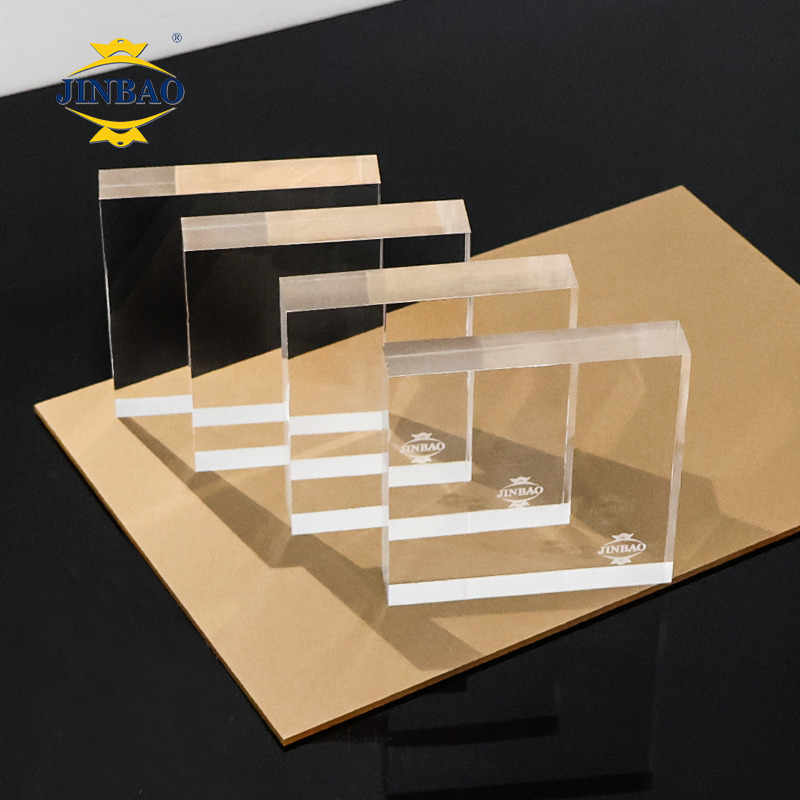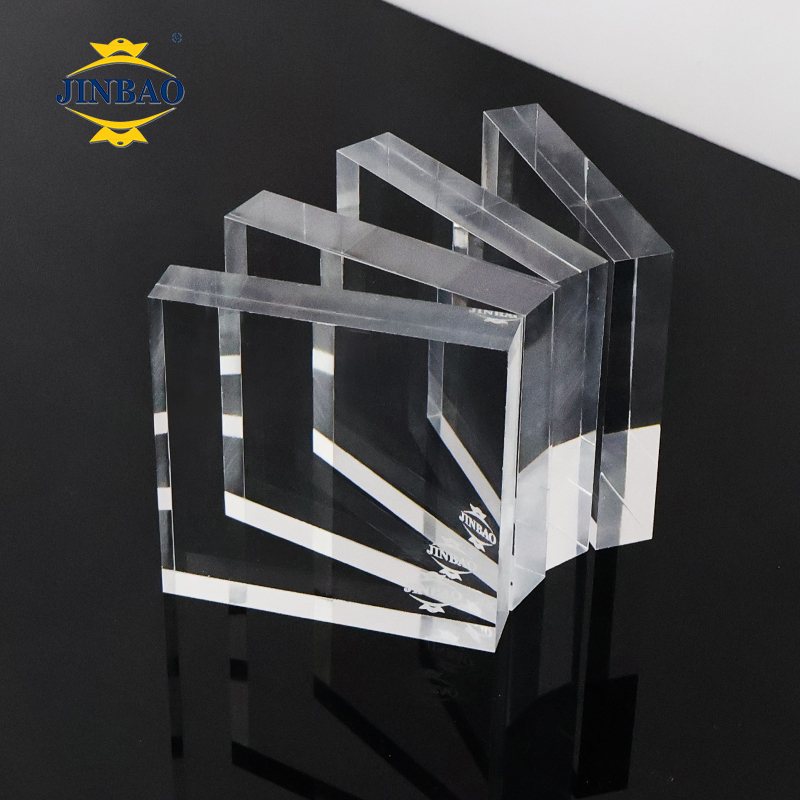Views: 0 Author: Jinbao Plastic Publish Time: 2025-11-05 Origin: https://www.jinbaoplastic.com/









I'll never forget the call I got from Mike, a fabricator in Phoenix, about six months ago. He was practically yelling into the phone: "These acrylic sheets are garbage! Half of them cracked when we tried to bend them, and the other half look like someone breathed on them wrong. The supplier said they were 'premium grade' but they're performing worse than the cheap stuff I used to buy."
Mike learned the hard way what a lot of us in this business already know - not all acrylic is created equal. The problem is, when you're standing in a warehouse looking at stacks of clear plastic sheets, they all pretty much look the same. It's only when you start working with them that the differences become painfully obvious.
I've been dealing with plastic materials for almost 30 years now, and I've seen this story play out hundreds of times. A company switches suppliers to save a few bucks, everything looks fine initially, then three months later they're dealing with cracked panels, yellowed materials, or sheets that won't machine properly. By then, it's too late - you're stuck with the material and facing angry customers.
The thing is, there are ways to spot quality differences before you buy, but you need to know what to look for. Most people focus on price and maybe thickness, but the real quality indicators are things most buyers never think to check.
The first thing I do when evaluating acrylic sheets is look at the surface under different lighting conditions. Good material has a mirror-like finish that reflects light cleanly. Cheap stuff often has tiny imperfections - embedded dust, flow marks from poor processing, or microscopic scratches that scatter light and make the surface look cloudy.
Here's a trick I learned years ago: stack three or four sheets together and look through them. Quality acrylic stays crystal clear even through multiple layers. Inferior material starts looking milky or hazy when you stack it up. This happens because cheap acrylic has internal stress and tiny imperfections that add up when you look through multiple sheets.
The edges tell a story too. When acrylic is manufactured properly, the edges cut clean and smooth. Poor quality material tends to chip or crack when you cut it, and the edges often look rough or have tiny stress cracks running into the sheet.
I always check color consistency by comparing multiple sheets under the same lighting. Good suppliers maintain tight color control, so clear sheets look identical and colored sheets match perfectly. With cheap material, you'll often see variations - some sheets look slightly yellow, others might have a blue tint, or colored sheets vary in intensity.
Thickness uniformity is huge, but most people don't bother checking it properly. I use a digital caliper to measure thickness at multiple points - corners, edges, and center. Quality acrylic sheets hold tight tolerances, usually within a few thousandths of an inch. Cheap material can vary significantly across a single sheet.
Why does this matter? Uneven thickness creates optical distortions and stress concentrations. In architectural applications, thickness variations show up as visible lines or waves. In structural applications, thin spots become failure points.
Flatness is another dead giveaway. Lay the sheet on a flat surface and look for gaps or warping. Quality material lies flat without any external pressure. Inferior sheets often have built-in stress that causes warping, bowing, or twisting. This internal stress will cause problems later, even if the sheet looks fine initially.
This is probably the most revealing test you can do, and it takes about 30 seconds. Take a small sample piece and slowly bend it. Quality acrylic bends smoothly without any stress whitening or cracking sounds. The material should feel consistent throughout the bend.
Cheap acrylic often makes crackling sounds when you bend it, or you'll see white stress marks appear in the bend area. Sometimes inferior material feels "notchy" as you bend it, like it's fighting you. These are all signs of poor processing or low-quality raw materials.
The recovery is just as important as the bend itself. Good material springs back to its original shape when you release the stress. Poor material may stay partially bent or develop permanent stress marks.
Use your fingernail or a plastic tool to make a light scratch on the surface. Quality acrylic resists scratching and any marks you do make tend to be shallow and hard to see. Cheap material scratches easily and the scratches are usually deep and obvious.
This test simulates real-world handling and installation conditions. If the material scratches during your test, imagine what it'll look like after installation when people are cleaning it or bumping into it.
Here's something most people never think to check: how does the material respond to temperature changes? Take a sample piece and put it in direct sunlight for an hour, then bring it inside. Quality acrylic handles temperature changes without warping or developing stress marks. Inferior material often warps, develops stress cracks, or changes dimensions noticeably.
This is especially important if your application involves outdoor use or temperature variations. Material that can't handle a simple temperature test definitely won't perform well in real applications.

Quality suppliers provide real test data - impact resistance numbers, optical clarity measurements, thickness tolerances, and chemical resistance information. This data comes from actual testing of the material you're buying, not generic product specifications copied from somewhere else.
Cheap suppliers often provide vague specifications or obviously copied data sheets. If the specs look too perfect or identical to other suppliers' data, that's a red flag. Real manufacturing produces some variation in properties, and honest suppliers document that variation.
Look for batch-specific test certificates. These show that the supplier actually tests each production run rather than just assuming everything is the same. Batch certificates also provide traceability if problems develop later.
Industry certifications can be meaningful, but you need to understand what they actually cover. Building code approvals, food contact certifications, and medical device approvals require specific testing and manufacturing controls that indicate serious quality systems.
Generic ISO certifications are nice but don't guarantee material quality. I've seen ISO-certified companies produce terrible materials and non-certified companies with excellent quality. The certification is only as good as how it's implemented.
What matters more is whether the supplier can explain their quality control processes and provide documentation of how they maintain consistency. Good suppliers are proud of their systems and happy to explain them. Poor suppliers get vague when you ask specific questions.
Architectural grade acrylic is the premium tier - tight tolerances, excellent optical properties, superior impact resistance, and extensive quality control. This material costs more but performs consistently in demanding applications.
Commercial grade offers good performance at moderate prices. It meets standard industry requirements but may not have the enhanced properties of architectural grade. For many applications, commercial grade provides excellent value.
Economy grade prioritizes low cost over performance. While suitable for some uses, economy grade often has relaxed quality standards and inconsistent properties. This is where you find most of the problem materials that cause headaches later.
The grade designation should match your application requirements. Using economy grade for architectural applications is asking for trouble, but using architectural grade for temporary signage is wasteful.
UV-stabilized grades cost more but provide superior outdoor performance. The UV stabilizers prevent yellowing and brittleness that destroy regular acrylic in outdoor applications.
Impact-modified grades incorporate rubber particles that improve toughness at the expense of optical clarity. These materials work well for protective applications but aren't suitable where optical perfection matters.
Chemical-resistant grades use different polymer formulations that resist specific chemicals but may have different processing characteristics or optical properties.
Each specialty formulation involves tradeoffs. Understanding these tradeoffs helps you select appropriate materials and avoid disappointment when specialty grades don't perform like standard materials in all respects.
When someone offers acrylic at prices significantly below market rates, there's always a reason. Usually, it's because they're cutting corners on raw materials, quality control, or manufacturing processes.
I've seen suppliers offer "premium" acrylic at economy prices by using recycled content, off-spec raw materials, or simplified manufacturing processes. The initial savings disappear quickly when you factor in higher scrap rates, processing problems, and field failures.
Legitimate cost advantages come from manufacturing efficiency, not material shortcuts. Suppliers who can explain their cost advantages usually have real efficiencies. Suppliers who can't explain why their prices are lower are usually hiding something.
Professional suppliers provide detailed technical information and can answer specific questions about their materials and processes. They understand their products and can explain how different grades perform in various applications.
Suppliers who provide vague answers, generic data sheets, or can't explain their manufacturing processes are usually resellers or low-quality manufacturers. They don't understand their own products well enough to provide meaningful technical support.
Missing batch information, unclear specifications, or reluctance to provide samples are all warning signs. Quality suppliers are confident in their materials and happy to provide samples and detailed information.
How a supplier handles your initial inquiries predicts how they'll handle problems later. Slow responses, unclear communication, or unwillingness to provide samples suggest poor customer service systems.
Quality suppliers understand that material selection requires technical discussion and are willing to invest time in helping you choose appropriate grades. They provide application guidance and processing recommendations based on experience.
Suppliers who just want to take your order without understanding your application are usually focused on volume rather than customer success. This approach leads to material selection mistakes and poor long-term relationships.
Always request samples before placing large orders, especially with new suppliers. Test the samples under conditions similar to your actual application. This investment in time and small sample costs can prevent expensive mistakes.
Test multiple sheets from the same batch to check consistency. Sometimes suppliers send their best material as samples, then deliver lower quality for production orders. Testing multiple samples helps identify this practice.
Document your test results so you can compare different suppliers objectively. Photos, measurements, and performance notes help you make informed decisions rather than relying on memory or impressions.

Finding good suppliers is only half the battle - maintaining good relationships ensures continued access to quality materials and technical support. Good suppliers value customers who understand quality and are willing to pay for it.
Communicate your requirements clearly and provide feedback on material performance. Quality suppliers use this information to improve their products and better serve your needs.
Consider the total cost of ownership, not just material prices. Quality materials that process easily, perform consistently, and don't require rework often cost less overall than cheap materials that cause problems.
The acrylic market is full of suppliers making quality claims, but the real test comes when you start using their materials. Learning to identify quality differences before you buy protects your projects, your reputation, and your profitability.
Mike, the fabricator I mentioned earlier, now tests every new supplier using these methods. He hasn't had a material failure in over a year, and his customers are much happier with the consistency and quality of his work. His material costs went up slightly, but his profits improved because he eliminated rework and warranty issues.
Looking for acrylic sheets that pass these quality tests consistently? Jinbao Plastic has been manufacturing premium acrylic since 1996, with 35 production lines producing 2,100 tons monthly. We maintain the quality control systems and material standards that separate premium products from inferior alternatives. Our range of sizes, thicknesses, and colors meets diverse business needs while delivering the consistency you can count on. Contact us to request samples and see the difference that real quality control makes.
Jinbao Group was established in 1996 and its head office is located in the beautiful spring city-Jinan, Shandong province.



